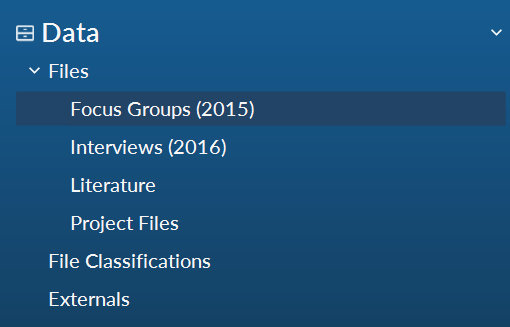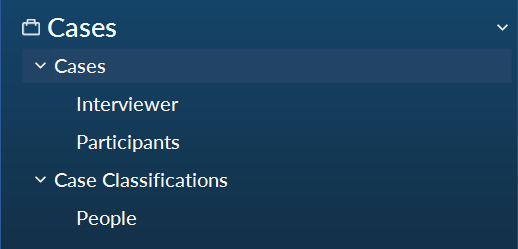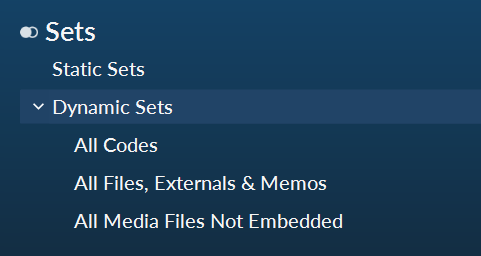Project File Overview
As a (very) quick overview and reminder of the main workspace areas within NVivo and how we have the project file for this afternoon setup:
Files
Data > Files

- Focus Groups (2015): Transcripts from three pre-general election focus groups from 2015.
- Interviews (2016): Fourteen telephone interviews on the EU Referendum in 2016.
- Literature: Containing two articles by QESB team members, one on using grounded theory, the other on using focus groups.
- Project Files: With files that contain additional information about the project, the research phases, and participants who took part.
Codes
Coding > Codes

- Codes: Top-level folder with some initial coding created during the Intro to NVivo workshop.
- Autocoded (Sections): Sub-folder with the broad-brush themes that were created auto-coding the Headings within the interview transcripts.
- Autocoded (Themes): Sub-folder with codes created by auto-coding ‘themes’.
We have “autocoded themes” within this document merely to provide a broad range of example codes to work with in the exercises. However, in practice, do not rely on such autocoding instead of creating and coding with your own codes.
Cases
Cases > Cases

Interviewer: Cases created when ‘autocoding by speaker’ that code transcript sections where an interviewer / moderator from the research team is speaking.
Participants: Cases created when ‘autocoding by speaker’ that code transcript sections where participants are speaking.
Case Classifications: Top-level folder contains the case classifications and their attributes. For this project, there is only one case classification - ‘People’.
- People: Sub-folder with all cases classified as ‘People’, where can see the attributes for specific participants. (Note - the interviewer cases are also classified as people, in many cases you would want to remove from the same classification as participants.)
Notes

- Memos: NVivo’s built-in note-taking system. Contains a few existing memos with further project info and reflectives on initial analysis.
- Framework Matrices: Create summaries for cases by node. Currently, empty.
- Annotations: Annotations added to files, with couple examples.
- See-Also Links: Use to link content/files to other content/files. Currently, empty.
Sets

- Static Sets: Manually created collections of project items, of any type. Think of this as a way to group and organise items for specific tasks without changing their primary structure. For example, a code can only exist within a single folder within the “Coding > Codes” section. However, it can be included within an unlimited number of static sets.
- Dynamic Sets: Collections of project items created based on search criteria. As they are criteria based they also auto-update based on any changes in your project. For example, if you had a dynamic set for all codes used to code focus group transcripts, each time you use a new code when coding the focus groups, it will automatically then be included in the dynamic set.
Dynamic Sets are a new name given to what were called ‘search folders’ in NVivo 12. They operate exactly the same, all that is different is the name.
Queries

- Query Criteria: Location to store saved queries, saving you from having to manually put them together each time.
- Query Results: Location to store query results. This can be useful for more complex queries that take a long-time to process to save having to re-run it every time – just remember it won’t reflect any changes to your project file. Query results can also be used to create new nodes and cases.
- Coding Matrices: Similar to the above but for the results of a coding matrix. By default manually created coding matrices saved results with be in Query Results, but they can manually moved across. Coding matrices automatically produced, such as when autocoding by theme, are stored here by default.

